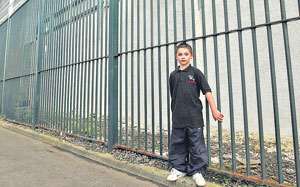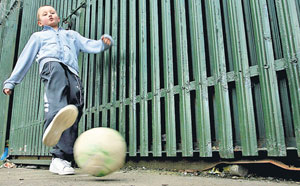
Belfast walls growing in size and number BELFAST (AP) - Lee Young, 8, and Cein Quinn, 7, live barely 200 yards apart, but they have never met, and maybe never will. Ten years after peace was declared in Northern Ireland, one might have expected that Belfast's barriers would be torn down by now. But reality, as usual, is far messier. Not one has been dismantled. Instead they've grown in both size and number. The past decade of peacemaking has brought political elites of both sides together in a Catholic-Protestant government in hopes that their example would trickle down. Their experiment in cooperation, highlighted by the power-sharing government's first anniversary on Thursday, has encouraged thriving employment, tourism and nightlife.
But it has not delivered meaningful reconciliation. Instead, for dozens of front-line communities of Belfast, fences still make the best neighbours."The Troubles" began at these sectarian flashpoints in the late 1960s, and survive today in a legacy of mutual fear and loathing. The rate of sectarian killings has fallen to virtually zero, thanks to cease-fires underpinned by IRA disarmament, and the feeling on both sides is that the barriers help keep that peace. "No. No way does that peace line come down," said Cein's mother, Allison Quinn, 32, sitting on her living room sofa on the Catholic side of the fence alongside her sister and a cousin. Despite its height, every so often a particularly strong-armed Protestant manages to hurl a brick over the top — enough to rattle any backyard barbecue. "It's definitely not safe to take it down, and I don't think it ever will be. There's bitter loyalists over there," Quinn said, using a term for anti-Catholic militants. "They're out drinking in the street at night. If you take it down, they'd have easy access here and come over starting fights. You'd just be asking for trouble." The wall 30 paces from her front door was born in 1969 as makeshift coils of barbed wire laid by British troops, shipped in following riots that forced hundreds of families, mostly Catholics, from their homes. At the time, the senior British army commander, Lt. Gen. Ian Freeland, predicted: "The peace line will be a very, very temporary affair. We will not have a Berlin Wall or anything like that in this city." But those barbed-wire coils became miles-long brick walls separating Catholic from Protestant in west Belfast. Even higher walls shield a Catholic enclave in Protestant east Belfast, while the north side is carved up by dozens of smaller barriers. In this city of 650,000, roughly half Catholic and half Protestant, only the university district and upper-class streets, chiefly on the south side, bear no clear-cut tribal identity. The newest peace line, erected earlier this year, runs past one of Belfast's few "integrated" elementary schools — a place where Catholic and Protestant students are deliberately brought together. Fewer than 3 percent of Northern Ireland kids attend such schools. Quinn, an unemployed single mother, says emphatically: "I would never move. It's so handy. And it's lovel.” Just then her boy Cein comes in, rubbing his head after bumping it on a curbstone while playing outside. He's soon immersed in his handheld video game. Asked if he's ever gone next door to see the Protestants, Cein says no. Would he like to meet his neighbours and play in their playground? "No way," he says with a smile. His mother shrugs. "I'd like him to mix with Protestant kids, but it's just not safe," she says. Outside Quinn's cul-de-sac, children's voices float over from beyond the wall. By day, when the peace line is opened for traffic, those kids are a few minutes' walk away. By dusk, when the doors are locked, it might take an hour. On the Protestant side of the wall is a fenced-in, concrete soccer field. Here a stranger is greeted by two boys who let loose with suspicious questions and bigoted quips. Their fathers belong to the UDA, the Ulster Defence Association, a militant Protestant group that killed more than 300 Catholics from 1971 to its 1994 cease-fire. "Are youse a taig?" says one burly boy, using an insulting word for an Irish Catholic. "It's all taigs over there," says another, waving dismissively at the wall. "They're soap-dodgers, so they are." Soap-dodgers? "Sure, them ones never take a shower. You can smell 'em from here." The boys laugh and resume their game. This is where Lee Young, Cein's neighbour, plays soccer. The boy wears the blue jersey of Glasgow Rangers, a Scottish soccer club with an exclusively Protestant following in Belfast. Were he to walk next door onto Catholic turf, he would be certain to suffer verbal bullying or worse — perhaps from kids wearing the green of Glasgow Celtic, the Catholic favourite. Wearing the "wrong" sports gear is just one of scores of sectarian measuring sticks that have proven deadly in the past. So are names. A "Cein" — a Gaelic name pronounced Keane — would be instantly identified as Irish Catholic, because the Protestant side shuns the Irish language. |
|
||||||
|| Front
Page | News | Editorial | Columns | Sports | Plus | Financial
Times | International | Mirror | TV
Times | Funday
Times || |
| |
Reproduction of articles permitted when used without any alterations to contents and a link to the source page.
|
© Copyright
2008 | Wijeya
Newspapers Ltd.Colombo. Sri Lanka. All Rights Reserved. |

